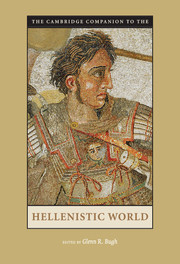Book contents
- Frontmatter
- Introduction
- 1 Alexander the Great and the Creation of the Hellenistic Age
- 2 The Hellenistic Kingdoms
- 3 The Polis and Federalism
- 4 Hellenistic Economies
- 5 The Hellenistic Family
- 6 History and Rhetoric
- 7 Material Culture
- 8 Hellenistic Art: Two Dozen Innovations
- 9 Language and Literature
- 10 Greek Religion: Continuity and Change in the Hellenistic Period
- 11 Philosophy for Life
- 12 Science, Medicine, and Technology
- 13 Hellenistic Military Developments
- 14 Greeks and Non-Greeks
- 15 Recent Trends and New Directions
- Hellenistic Dynasties
- Works Cited
- Index
4 - Hellenistic Economies
Published online by Cambridge University Press: 28 November 2007
- Frontmatter
- Introduction
- 1 Alexander the Great and the Creation of the Hellenistic Age
- 2 The Hellenistic Kingdoms
- 3 The Polis and Federalism
- 4 Hellenistic Economies
- 5 The Hellenistic Family
- 6 History and Rhetoric
- 7 Material Culture
- 8 Hellenistic Art: Two Dozen Innovations
- 9 Language and Literature
- 10 Greek Religion: Continuity and Change in the Hellenistic Period
- 11 Philosophy for Life
- 12 Science, Medicine, and Technology
- 13 Hellenistic Military Developments
- 14 Greeks and Non-Greeks
- 15 Recent Trends and New Directions
- Hellenistic Dynasties
- Works Cited
- Index
Summary
Preliminaries and Problems
The kingdoms, cities, and other political institutions described in earlier chapters give shape and meaning to our geographical and cultural ideas of the Hellenistic era, whereas the creation, expansion, decline, and eventual extinction of the monarchies provide a chronological framework, even if it is hard to define closure more narrowly than (say) 150-131 b.c. Economically, however, no such tidy delineations are possible. The economic historian is concerned above all to trace and explain change over time, and variation by locality, in such human behaviour as involves the use of resources - supply and demand, access, institutions, security, and technologies, as well as social values and attitudes towards getting and spending. Political and institutional boundaries, therefore, matter only insofar as they affect the movement of goods and persons, or generate differing levels of taxation and redistribution, whereas cultural boundaries and conventions matter only insofar as they influence patterns of production and consumption or as they inhibit or encourage that elusive process that economists call “growth.” Similarly, just as there is no intrinsic reason why a particular epoch, defined politically, should show a distinctive type of economy, so too there is no reason why a single kingdom, region, or city should show only one type of economic behaviour: indeed it cannot, for otherwise change would be impossible. All the more is that true when the ecologies of the areas controlled or influenced by the Hellenistic monarchies varied so enormously, from the baking deserts of Saudi Arabia or southern Iran via the intensive irrigation agriculture of Mesopotamia and the dry-farming Aegean-Anatolian region to the Alpine habitats of northern Macedonia.
- Type
- Chapter
- Information
- The Cambridge Companion to the Hellenistic World , pp. 73 - 92Publisher: Cambridge University PressPrint publication year: 2006
- 6
- Cited by

